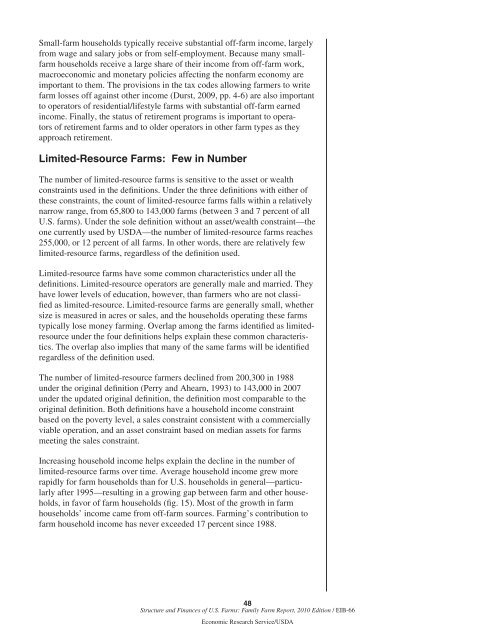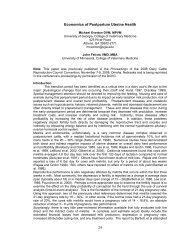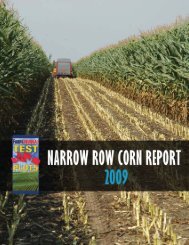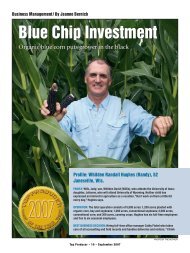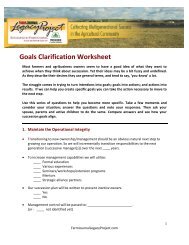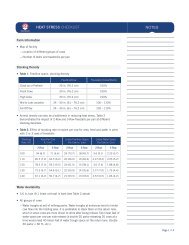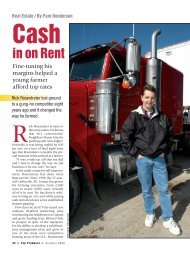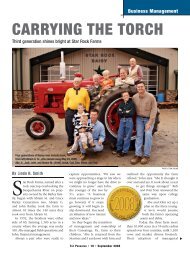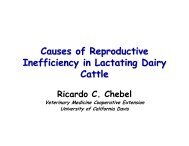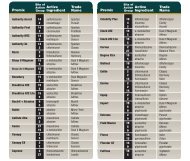Structure and Finances of U.S. Farms: Family Farm Report ... - AgWeb
Structure and Finances of U.S. Farms: Family Farm Report ... - AgWeb
Structure and Finances of U.S. Farms: Family Farm Report ... - AgWeb
You also want an ePaper? Increase the reach of your titles
YUMPU automatically turns print PDFs into web optimized ePapers that Google loves.
Small-farm households typically receive substantial <strong>of</strong>f-farm income, largelyfrom wage <strong>and</strong> salary jobs or from self-employment. Because many smallfarmhouseholds receive a large share <strong>of</strong> their income from <strong>of</strong>f-farm work,macroeconomic <strong>and</strong> monetary policies affecting the nonfarm economy areimportant to them. The provisions in the tax codes allowing farmers to writefarm losses <strong>of</strong>f against other income (Durst, 2009, pp. 4-6) are also importantto operators <strong>of</strong> residential/lifestyle farms with substantial <strong>of</strong>f-farm earnedincome. Finally, the status <strong>of</strong> retirement programs is important to operators<strong>of</strong> retirement farms <strong>and</strong> to older operators in other farm types as theyapproach retirement.Limited-Resource <strong><strong>Farm</strong>s</strong>: Few in NumberThe number <strong>of</strong> limited-resource farms is sensitive to the asset or wealthconstraints used in the definitions. Under the three definitions with either <strong>of</strong>these constraints, the count <strong>of</strong> limited-resource farms falls within a relativelynarrow range, from 65,800 to 143,000 farms (between 3 <strong>and</strong> 7 percent <strong>of</strong> allU.S. farms). Under the sole definition without an asset/wealth constraint—theone currently used by USDA—the number <strong>of</strong> limited-resource farms reaches255,000, or 12 percent <strong>of</strong> all farms. In other words, there are relatively fewlimited-resource farms, regardless <strong>of</strong> the definition used.Limited-resource farms have some common characteristics under all thedefinitions. Limited-resource operators are generally male <strong>and</strong> married. Theyhave lower levels <strong>of</strong> education, however, than farmers who are not classifiedas limited-resource. Limited-resource farms are generally small, whethersize is measured in acres or sales, <strong>and</strong> the households operating these farmstypically lose money farming. Overlap among the farms identified as limitedresourceunder the four definitions helps explain these common characteristics.The overlap also implies that many <strong>of</strong> the same farms will be identifiedregardless <strong>of</strong> the definition used.The number <strong>of</strong> limited-resource farmers declined from 200,300 in 1988under the original definition (Perry <strong>and</strong> Ahearn, 1993) to 143,000 in 2007under the updated original definition, the definition most comparable to theoriginal definition. Both definitions have a household income constraintbased on the poverty level, a sales constraint consistent with a commerciallyviable operation, <strong>and</strong> an asset constraint based on median assets for farmsmeeting the sales constraint.Increasing household income helps explain the decline in the number <strong>of</strong>limited-resource farms over time. Average household income grew morerapidly for farm households than for U.S. households in general—particularlyafter 1995—resulting in a growing gap between farm <strong>and</strong> other households,in favor <strong>of</strong> farm households (fig. 15). Most <strong>of</strong> the growth in farmhouseholds’ income came from <strong>of</strong>f-farm sources. <strong>Farm</strong>ing’s contribution t<strong>of</strong>arm household income has never exceeded 17 percent since 1988.48<strong>Structure</strong> <strong>and</strong> <strong>Finances</strong> <strong>of</strong> U.S. <strong><strong>Farm</strong>s</strong>: <strong>Family</strong> <strong>Farm</strong> <strong>Report</strong>, 2010 Edition / EIB-66Economic Research Service/USDA


